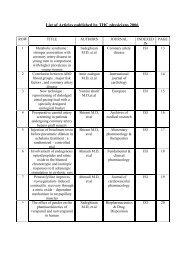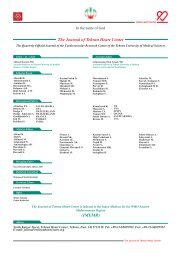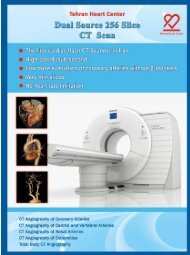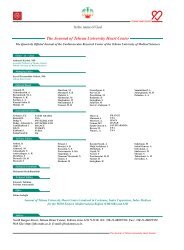Journal of Tehran University Heart Center
Journal of Tehran University Heart Center
Journal of Tehran University Heart Center
Create successful ePaper yourself
Turn your PDF publications into a flip-book with our unique Google optimized e-Paper software.
Transcatheter Closure <strong>of</strong> Atrial Septal Defect with Amplatzer Septal Occluder ...<br />
TEHRAN HEART CENTER<br />
Figure1. Sizing procedure using sizing balloon catheter; waist <strong>of</strong> the balloon<br />
clearly indicates the stretch diameter <strong>of</strong> the atrial septal defect (arrows)<br />
A<br />
The compressed ASO was then advanced through the long<br />
sheath that had previously been positioned in the left atrium.<br />
Under fluoroscopic control, the left atrial disc was extruded<br />
by advancing the delivery cable. After the distal disc was<br />
deployed in the middle left atrium, the delivery system was<br />
gently pulled back against the atrial septum. The ASO was<br />
thereafter fully deployed by withdrawing the sheath over the<br />
delivery cable to expand the right atrial disc. The position and<br />
stability <strong>of</strong> the ASO was assessed by fluoroscopy and TTE.<br />
Care was taken to ensure that the device did not obstruct<br />
the right pulmonary veins, caval veins, coronary sinus, or<br />
the mitral valve. Any residual shunt was evaluated by twodimensional<br />
color-flow Doppler. The residual shunt was<br />
defined as a leak traversing or passing between the two discs<br />
<strong>of</strong> the ASO or around the device edges to the right atrium and<br />
was detected by two-dimensional color-flow Doppler. The<br />
residual shunt was classified according to the color-jet width<br />
describe by Boutin and her colleagues 10 as trace < 1 mm, 2<br />
mm > small > 1mm, 4 mm > moderate > 2 mm, and large<br />
> 4 mm. If the width <strong>of</strong> the color Doppler flow was < 2mm,<br />
2-4mm, and > 4mm; the residual shunts were classified as<br />
mild, moderate, and severe, respectively. The device was<br />
subsequently released from the delivery system, and final<br />
assessment <strong>of</strong> the position <strong>of</strong> the device was made via TTE.<br />
After the release <strong>of</strong> the device, right atrium angiography<br />
with follow-through was carried out in the hepatoclavicular<br />
projection (Figure 2).<br />
As a matter <strong>of</strong> routine, after ASD closure, the patients<br />
remained in the general ward <strong>of</strong> the hospital for one night<br />
and received heparin 100 IU/kg/daily (partial thromboplastin<br />
time [PTT] 50-60 seconds) for twenty-four hours. TTE was<br />
performed twenty-four hours after the procedure and before<br />
hospital discharge to ensure the suitable deployment <strong>of</strong> the<br />
device and to look for any residual shunt.<br />
B<br />
C<br />
Figure 2. Transcatheter closure steps by fluoroscopy. Deployment <strong>of</strong> the left<br />
and right discs <strong>of</strong> an Amplatzer device with the central waist stenting the<br />
atrial septal defect (A); contrast injection in right atrium showing suitable<br />
device position and no residual shunt through the device (B); and complete<br />
deployment <strong>of</strong> the Amplatzer septal occluder after release <strong>of</strong> device from<br />
delivery cable (C)<br />
The <strong>Journal</strong> <strong>of</strong> <strong>Tehran</strong> <strong>University</strong> <strong>Heart</strong> <strong>Center</strong>81
















